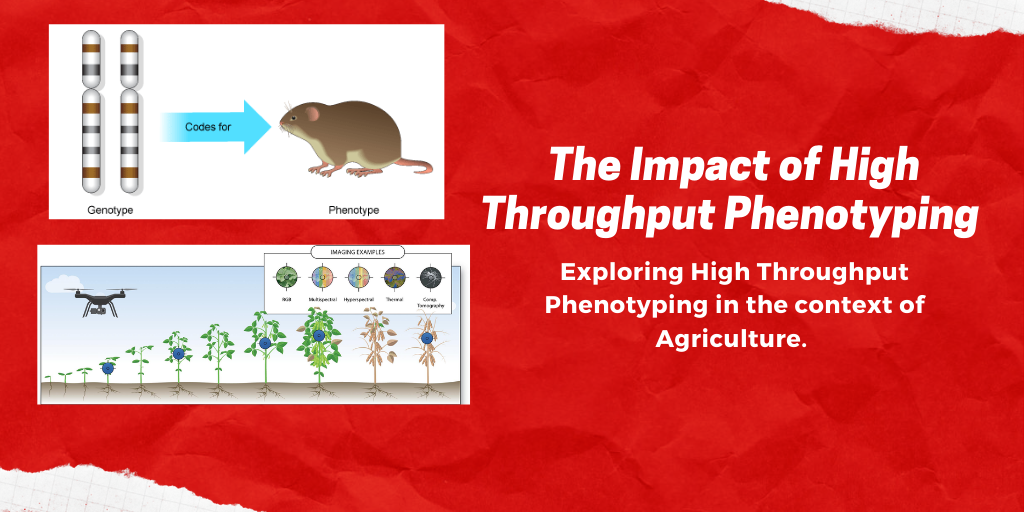The Impact of High Throughput Phenotyping

Legend: High throughput phenotyping is the quantification of an organism’s expressed genetic
traits. These expressed genetic traits are called phenotypes. Phenotypes are a culmination of
genetic traits as well as environmental factors. High throughput phenotyping allows scientists to
target and isolate genes and environmental conditions that are responsible for a given
phenotype. This lesson outlines what high throughput phenotyping is and how it is being used
and applied in agricultural practices today. The top image (5) displays the relationship between
the genotype and phenotype. It must be noted that some genes give rise to numerous
phenotypes and multiple genes can give rise to just one phenotype. The bottom image (4)
shows the application of proximal sensing to construct a phenotypic chart of numerous plants.
Introduction/Background:
What is high throughput phenotyping?
A phenotype is the culmination of physical characteristics that are directly observable. A
phenotype is a direct manifestation of your genes. Genes along with personal experience shape
your phenotype (5). Simply put, high throughput phenotyping has the ability to quantify things
such as stress factors, rates of crop growth, and overall crop health (1). This information allows
scientists to take a more succinct and corrective action against damaged or stunted organisms.
High throughput phenotyping is based in robotics and is an emerging field in engineering. This
approach is focused on rapid, nondestructive sensing technology that enables increased
capture of measurements in the field of relevant phenotypes. High throughput phenotyping is
necessary to advance the understanding of genotype-to-phenotype and accelerate plant
breeding (6). These budding technologies have the potential to revolutionize our understanding
of plant biology and agricultural practices. In terms of high throughput sequencing in general,
high throughput phenotyping focuses on the implementation of robotics and automation which
allows for a higher yield of phenotypic data from a greater number of organisms. This is done to
decrease overall costs and make the process of phenotype data collection more efficient overall.
How does high throughput phenotyping work?
High throughput phenotyping utilizes automation and robotics in order to increase the
process of phenotypic data acquisition. In particular, high throughput phenotyping focuses on
accurate, fast, non-invasive, automated, and reliable methods as far as data acquisition is
concerned (3). It allows information concerning plant functioning and activation of genes, and
the interaction of gene networks at different stages of plant development and in response to
environmental stimulus can be exploited (4). The use of LiDAR (Light Detection and Ranging) is
one of the main tools being incorporated into high throughput phenotyping as an imaging tool.
Its ability to render 3D structures is extremely proficient as it takes numerous parameters into
consideration such as vegetation cover, height, canopy structure, leaf area index, and nitrogen
status (3). The use of LiDAR in concert with ground imaging sensors of similar resolution will
enable the agriculture community and plant biologists to have a more complete picture of not
only the 3D plant structure but also the interworking root mechanism below. High throughput
phenotyping is an exciting field at the moment as it includes various technological applications
to answer some of the most pertinent questions of biology.
Where is high throughput phenotyping being applied?
As far as crop improvement is concerned the agricultural community is looking towards
high throughput phenotyping. Currently the largest issue facing the agriculture community is
limited in their ability to rapidly and accurately phenotyping very large numbers of field-grown
plants (2). High throughput phenotyping right now is limited to plants grown in greenhouses or
growth chambers. Now the agriculture community has become “interest[ed] in adapting
agricultural machinery and electronic sensors for field-based high-throughput phenotyping” (2).
In particular, the use of proximal sensing to aid high throughput phenotyping is one of the
largest applications being pursued by the agriculture community right now. High throughput
phenotyping would allow for time series measurements that track crop development through its
life stages relative to how it responds to the environment (4). What makes this approach high
throughput is the fact that enabling a plant phenotyping system to record multiple types of data
in a single pass would not only increase throughput, but would also enable more accurate and
comprehensive specification of phenotypes (2). The current plan focuses on the deployment of
replicated sets of varying sensors near plants which thus enable the simultaneous phenotyping
of numerous traits from numerous rows of plants. One of the main phenotypes that is difficult for
scientists to assess with current high throughput technologies is lodging. Lodging is the
permanent displacement of the plant stem from vertical position (6). The use of proximal
sensing offers scientists the ability to have a more total view as to the nature of this phenotype
across various plants and various rows. This concept is exciting as high throughput phenotyping
has been so quickly adapted to aid in strengthening our agricultural practices as there is a
constant struggle to increase crop yield as well as abiotic stress tolerance.
References:
1. Allen L. High-throughput phenotyping: Sensing technologies and data mining.
Maximumyield.com. [accessed 2021 Apr 27].
https://www.maximumyield.com/high-throughput-phenotyping-sensing-technologies-anddata-
mining/2/17228
2. Andrade-Sanchez P, Gore MA, Heun JT, Thorp KR, Carmo-Silva AE, French AN,
Salvucci ME, White JW. Development and evaluation of a field-based high-throughput
phenotyping platform. Functional plant biology: FPB. 2013 [accessed 2021 Apr
26];41(1):68–79.
3. Kim J, Kim K-S, Kim Y, Chung YS. A short review: Comparisons of high-throughput
phenotyping methods for detecting drought tolerance. Scientia agricola. 2021 [accessed
2021 Apr 26];78(4).
https://www.scielo.br/scielo.php?script=sci_arttext&pid=S0103-90162021000401801&tln
g=en. doi:10.1590/1678-992x-2019-0300
4. Moreira FF, Oliveira HR, Volenec JJ, Rainey KM, Brito LF. Integrating high-throughput
phenotyping and statistical genomic methods to genetically improve longitudinal traits in
crops. Frontiers in plant science. 2020;11:681
5. Phenotype vs genotype – difference between. Theydiffer.com. 2016 [accessed 2021 Apr
27]. https://theydiffer.com/difference-between-phenotype-and-genotype/
6. Singh D, Wang X, Kumar U, Gao L, Noor M, Imtiaz M, Singh RP, Poland J.
High-throughput phenotyping enabled genetic dissection of crop lodging in wheat.
Frontiers in plant science. 2019;10. http://dx.doi.org/10.3389/fpls.2019.00394.
doi:10.3389/fpls.2019.00394